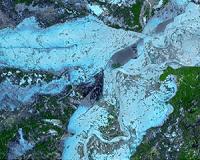 |
Huntsville AL (SPX) Oct 08, 2010 Using data from several research satellites, scientists will spend the next three years trying to understand the climate impacts of about 770 million tons of dust carried into the atmosphere every year from the Sahara Desert. Some Saharan dust falls back to Earth before it leaves Africa. Some of it streams out over the Atlantic Ocean or Mediterranean Sea, carried on the wind as far away as South America and the southeastern U.S. All of it has an as-yet unmeasured impact on Earth's energy budget and the climate by reflecting sunlight back into space. "The people who build climate models make some assumptions about dust and its impact on the climate," said Dr. Sundar Christopher, a professor of atmospheric science at The University of Alabama in Huntsville. Christopher will use a $500,000 grant from the Cloud-Aerosol Lidar and Infrared Pathfinder Satellite Observations (CALIPSO) mission, developed and managed by NASA's Langley Research Center in Hampton, Va. CALIPSO is an Earth observing satellite that provides new insight into the role that clouds and atmospheric aerosols play in air quality, weather and climate. Christopher will use both CALIPSO and Aqua satellite data in his research. Aqua was the first member launched of a group of satellites termed the Afternoon Constellation, or A-Train, a group of satellites that travel in line, one behind the other, along the same track, as they orbit Earth. Combining the information from several instruments gives a more complete answer to many questions about Earth's atmosphere than would be possible from any single satellite observation taken by itself.
Understanding Dust Dust is one kind of particle, or aerosol, that floats around in the atmosphere. Most of the recent research into aerosols has focused on particles made by humans, such as smoke, soot or other types of pollution. "There has been a lot of research looking at the climate effects of man-made aerosols," Christopher said. "Particles from smoke and burning fossil fuels are tiny, sub-micron size. Many of these tiny particles cool the atmosphere because they reflect sunlight back into space before it has a chance to heat the air. That means less solar energy is available at the surface to heat the planet." Dust particles have a significant effect on heat energy in the air. Dust absorbs thermal energy rising from the ground and re-radiates it either toward space (and colder temperatures) or back toward the surface. "One thing we want to do is calculate how reflective dust is, because not all dust is created equal," said Christopher. "We're trying to calculate reflectivity so we can say with precision how much sunlight is being reflected." The composition and shape of dust particles is very complex. They are not spherical, which makes calculating their energy budget challenging and time consuming. Also, the composition of dust varies depending on which part of the Sahara the dust comes from. Some of it absorbs more solar energy than others. "Climate models are not very sophisticated in the way they handle dust," Christopher said. "And the long-wave or infrared part is something that has been ignored for a long time. We want to nail down those values." "NASA researchers are especially interested in understanding how dust might suppress hurricane formation and provide nutrients for marine life," said Langley's Dr. Chip Trepte, the CALIPSO project scientist.
Why the Sahara? That means the dust in the atmosphere looks very much like the surface below it. Only in the past few years have new instruments and new techniques been developed that help scientists "see" which is dust and which is desert. The CALIPSO satellite's instruments include a lidar, which shoots a laser into the atmosphere, then catches light that bounces off particles in the air to learn more about aerosols. CALIPSO is a collaboration between NASA and France's Centre National d'Etudes Spatiales.
Share This Article With Planet Earth
Related Links University of Alabama at Huntsville Earth Observation News - Suppiliers, Technology and Application
 NASA Study Sees Earth's Water Cycle Pulse Quickening
NASA Study Sees Earth's Water Cycle Pulse QuickeningDhanbad, India (SPX) Oct 07, 2010 Freshwater is flowing into Earth's ocean in greater amounts every year, thanks to more frequent and extreme storms related to global warming, according to a first-of-its-kind study by a team of NASA and university researchers. The team, led by Tajdarul Syed of the Indian School of Mines, Dhanbad, India, and formerly with the University of California, Irvine, used NASA and other world-scale ... read more |
|
| The content herein, unless otherwise known to be public domain, are Copyright 1995-2010 - SpaceDaily. AFP and UPI Wire Stories are copyright Agence France-Presse and United Press International. ESA Portal Reports are copyright European Space Agency. All NASA sourced material is public domain. Additional copyrights may apply in whole or part to other bona fide parties. Advertising does not imply endorsement,agreement or approval of any opinions, statements or information provided by SpaceDaily on any Web page published or hosted by SpaceDaily. Privacy Statement |